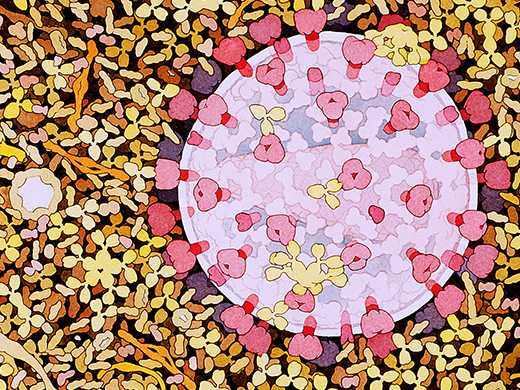Virus controls progression of HIV infection
A research team has discovered that the HI virus itself determines the host viral load to a surprisingly high degree. This has a major impact on the development of HIV infections into AIDS. In an interview with ETH News the infection researchers Sebastian Bonhoeffer and Gabriel Levanthal describe how they came to this realisation and what conclusions they draw from it.

You don’t tend to hear a lot about HIV and AIDS anymore. In a new study you take a look at the infection from the “perspective of evolutionary biology”. What’s this about?
Sebastian Bonhoeffer: We demonstrate that the degree of viral infection – viral load – is determined by the virus itself to a far higher degree than previously assumed. As the viral load influences the progression of the infection, this means, conversely, that the patient’s genes are less important when it comes to the course of an HIV infection.
How did you come to realise that the viral genotype is the determining factor as to whether a patient has a high or lower viral load?
Gabriel Leventhal: I would like to answer this question by giving you an example: virus carrier A passes on the virus to recipient B. We measure a viral load of 150,000 virus particles per specific amount of blood in A and 120,000 in B after some time. In a different pair the donor value C is 10,000, the recipient value D 13,000. Why doesn’t recipient D have 150,000 particles? The answer is: because the virus largely determines this value itself. If the viral load is very similar for two individuals who are completely different genetically, the reason must lie with the virus itself. Only if donor and recipient were genetically similar, would we have to assume that their genes influence the viral load.
What triggers the increase in viral load and, by extension, the development of the disease into AIDS?
GL: The typical course of HIV is like this. After initial infection the number of virus particles in blood increases markedly and rapidly. After around three months it falls to a certain level. We call this the set-point viral load. Often this remains stable over a longer period. But then the virus starts replicating and the viral load in blood increases markedly – AIDS breaks out. We don’t know what exactly triggers this rapid increase at a specific point in time.
Can you put a figure on the proportion of the viral genotype in the attribute viral load?
GL: In our study we calculate a viral genotype share of 30 percent in the attribute viral load – that is a really large share. The host and its genotype only account for around 20 percent. The other 50 percent are accounted for by as yet unknown factors.
What does that mean?
SB: The virus determines the viral load, the viral load the progression of the disease. Furthermore, the virus itself also evolves very quickly. That’s why the evolution of the virus is so relevant for the course of the disease.
GL: For instance, it has been demonstrated that the evolution of the virus has adjusted the viral load in such a way that there is maximum transmission. If the viral load is too low or too high, then overall there is not sufficient transmission. Either because not enough viruses are present for efficient transmission per contact or because of this high viral load the sick person experiences a faster course of the disease and then there are fewer transmission opportunities overall. Hence it adjusts to an optimum.
Can these descriptions be applied in general to all HIV infections?
SB: The situation we are describing only applies to untreated patients. We scarcely come across any in western industrial countries and even in developing countries where HIV is the most widespread, more and more people are receiving appropriate treatment. This is one criticism that could be made of our study: it is not directly applicable to the current situation in most industrial countries in which there are no “naturally” progressing HIV infections.
What conclusions can be drawn from your study about the conditions in western countries?
SB: Our study looks from an evolutionary perspective at the virus and the course of an infection in patients. We want to completely understand which factors – viral genotype, patient genotype or environment – determine the course of infection. The fact that the virus may be largely responsible for the viral load is extremely exciting for me. That would mean that there are as yet unknown mechanisms which influence the course of the disease through the virus.
GL: These mechanisms or the underlying genes are also shaped by evolution. Medicinal treatment creates a different environment for the virus from “natural” infection. It is, therefore, possible that part of the viral genotype is modified by us through treatment. Our work predicts specific properties of these genes. This considerably narrows down the search and helps us to identify these genes in experiments. The viral load is the determining factor for the course of the disease. Once we have a better understanding of what determines the viral load, we will be able to improve treatment options in the long term.
Sebastian Bonhoeffer has been a Professor at the Institute of Theoretic Biology of ETH Zurich since 2005. His research focuses on mathematical models which describe the population dynamics of viral infections in infected individuals. His models have provided important insight into the pathogenesis of viruses in particular the HI virus.
30-year old Gabriel Leventhal is a doctoral student in Sebastian Bonhoeffer’s group. He’s studying the evolution and epidemiology of infectious diseases.
Further reading
Fraser C, Lythgoe K, Leventhal GE, Shirreff G, Hollingsworth TD, Alizon S, Bonhoeffer S. Virulence and Pathogenesis of HIV-1 Infection: An Evolutionary Perspective. Science 21 March 2014: 343 (6177), 1243727. DOI:external page10.1126/science.1243727call_made
